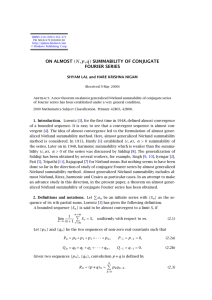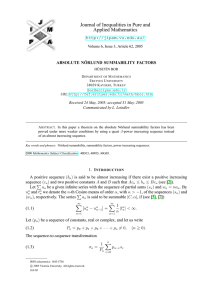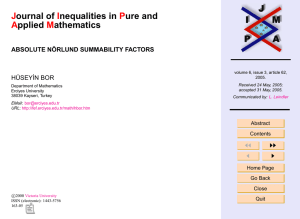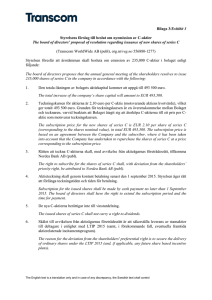On Absolute Weighted Mean | , |k A δ
advertisement
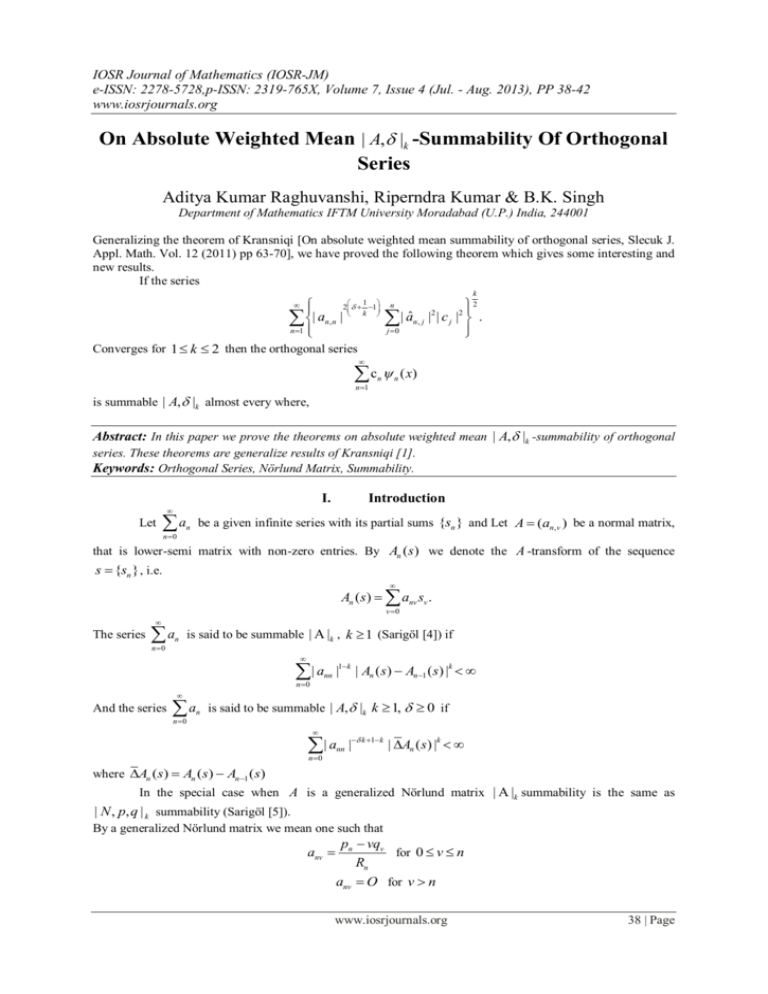
IOSR Journal of Mathematics (IOSR-JM)
e-ISSN: 2278-5728,p-ISSN: 2319-765X, Volume 7, Issue 4 (Jul. - Aug. 2013), PP 38-42
www.iosrjournals.org
On Absolute Weighted Mean | A, |k -Summability Of Orthogonal
Series
Aditya Kumar Raghuvanshi, Riperndra Kumar & B.K. Singh
Department of Mathematics IFTM University Moradabad (U.P.) India, 244001
Generalizing the theorem of Kransniqi [On absolute weighted mean summability of orthogonal series, Slecuk J.
Appl. Math. Vol. 12 (2011) pp 63-70], we have proved the following theorem which gives some interesting and
new results.
If the series
1
2 1
k
| an,n |
n 1
k
2
2
2
ˆ
| an , j | | c j | .
j 0
n
Converges for 1 k 2 then the orthogonal series
c
n 1
n
n
( x)
is summable | A, |k almost every where,
Abstract: In this paper we prove the theorems on absolute weighted mean | A, |k -summability of orthogonal
series. These theorems are generalize results of Kransniqi [1].
Keywords: Orthogonal Series, Nörlund Matrix, Summability.
I.
Let
a
n 0
Introduction
be a given infinite series with its partial sums {sn } and Let A (an,v ) be a normal matrix,
n
that is lower-semi matrix with non-zero entries. By An ( s) we denote the A -transform of the sequence
s {sn } , i.e.
An ( s) anv sv .
v 0
The series
a
n 0
n
is said to be summable | A |k , k 1 (Sarigöl [4]) if
| a
n0
And the series
a
n 0
n
|1 k | An ( s) An 1 ( s) |k
nn
is said to be summable | A, |k k 1, 0 if
| a
nn
n0
| k 1 k | An ( s) |k
where An (s) An ( s) An1 ( s)
In the special case when A is a generalized Nörlund matrix | A |k summability is the same as
| N , p, q | k summability (Sarigöl [5]).
By a generalized Nörlund matrix we mean one such that
anv
pn vqv
for 0 v n
Rn
anv O for v n
www.iosrjournals.org
38 | Page
On Absolute Weighted Mean
| A, |k -Summability Of Orthogonal Series
where for given sequences of positive real constant p { pn } and q {qn } , the convolution Rn ( p q)n is
defined by
v 0
v 0
( p * q)n pv qn v pv v qv
where ( p * q)n 0 for all n , the generalized Nörlund transform of the sequence {sn } is the sequence
{tnp ,q ( s)} defined by
1
Rn
tnp ,q ( s)
p
m 0
q s
nm m m
and | A |k summability reduces to the following definition:
The infinite series
a
n 0
n
is absolutely summable | N,p,q |k k 1 if the series
Rn
n 0 qn
k 1
| tnp ,q ( s) tnp,1q ( s) |k
and we write
a
n 0
n
| N , p,q |k
Let { ( x)} be an orthonormal system defined in the interval (a, b) . We assume that f ( x) belongs to
L2 (a, b) and
f ( z ) ~ cn n f ( x)
(1.1)
n0
where cn
b
a
we write Rnj
f ( x) n ( x)dx, n 0,1,2...
p
v j
and Pn ( p *1) n
q , Rnn 1 0, Rn0 Rn
n v v
v 0
v 0
pv and Qn (1* q)n qv
Regarding to | N , p, q |1 | N , p, q | , summability of orthogonal series (1.1) the following two theorems are
proved.
Theorem 1.1 (Okuyama [3]) If the series
1/ 2
n R j R j 2
n
n 1 | c j |2
Rn 1
n 0 j 1 Rn
then the orthogonal series cn n ( x) is summable | N , p, q | almost every where.
Theorem 1.2 (Okuyama [3]) Let {(n)} be a positive sequence such that {(n) / n} is a non increasing
sequence and the series
(n(n))
n 1
1
converges. Let { pn } and {qn } be non negative. If the series
| cn |2 (n)w(1) (n) converges then the orthogonal series
n 1
c
j 0
j
j
( x) | N , p, q | almost everywhere, where
w((1)n ) is defined by
2
Rj Rj
w j n n n 1 .
n j
Rn Rn 1
The main purpose of this paper is studying of the | A, |k summability of the orthogonal series (1.1),
for 1 k 2 . Before starting the main result we introduce some further notations.
(1)
( j)
1
2
www.iosrjournals.org
39 | Page
On Absolute Weighted Mean
| A, |k -Summability Of Orthogonal Series
ˆ aˆ as follows
Given a normal matrix A anv , we associates two lower semi matrices A an,v and A
n ,v
an,v ani , n, i 0,1, 2
i v
and aˆnv anv an 1,v , aˆ00 a00 , n 1,2,... .
It ma be noted that A and  are the well-known matrices of series-to-sequence and series-to-series
transformations resp.
Throughout this paper we denote by Ka constant that depends only on k and may be different in different
relations.
II.
Main Results
We prove the following theorems:
Theorem 2.1 If the series
1
2 1
k
|
a
|
n,n
n 1
| aˆn , j | | c j |
j 0
n
2
k /2
2
Converges for 1 k 2 , then the orthogonal series
c
n
n0
n
( x)
is summable | A, |k almost every where.
Proof. For the matrix transform An (s)(x) of the partial sums of the orthogonal series
c
n0
n
n
( x) we have
n
An ( s )( x) anv sv ( x )
v 0
n
v
v 0
j 0
an ,v c j n ( x)
n
n
j 0
v 0
c j n ( x) anv
n
an , j c j n ( x)
j 0
v
where
c
j 0
j
n
( x) is the partial sum of order v of the series (1.1)
Hence
n 1
An ( s )( x) an , j c j j ( x) an 1, j c j j ( x )
j 0
j 0
n 1
an ,n c j n ( x) (an , j an 1, j )c j j ( x)
j 0
n 1
aˆn ,n c j n ( x) aˆn , j c j j ( x)
j 0
n
aˆn , j c j j ( x)
j 0
Using the Hölder’s inequality and orthogonality to the latter equality we have
www.iosrjournals.org
40 | Page
On Absolute Weighted Mean
b
a
1
| An ( s)( x) | dx (b a)
k
k
2
| A, |k -Summability Of Orthogonal Series
| A (s)( x) A
b
n 1
n
a
2
( s)( x) | dx
K
2
K
k
1
2
(b a)
2 2
b n
aˆn , j c j j ( x)
a j 0
Thus the series
| a
b
nn
n 1
|1 k k | An ( s)( x) |k dx
a
2
2 2
k
k | ann |
n 1
| aˆn, j |2 | c j |2
j 0
n
k /2
(2.1)
Converges by the assumption.
From this fact and since the function | An ( s)( x) | are non negative and by Lemma of Beppo-Levi [2] we have
| a
nn
n 1
|1 k k | An ( s)( x) |k
Converges almost every where.
This completes the proof of theorem.
If we put
1
H ( k ) ( A; , j )
j
n
2
1 n j
k
2
k
2
| nann | k
2 2
| aˆn, j |2
(2.2)
then the following theorem holds true.
( n )
is a non decreasing
n
Theorem 2.2: Let 1 k 2 and {(n)} be a positive sequence such that
sequence and the series
1
n(n)
converges. If the following series
n 1
n 1
converges, then the orthogonal series
| c
c
n0
n
n
n
2
1
|2 k (n) H k ( A, , n)
( x) | A, |k almost every where, where H k ( A, , n) is defined
by (2.2)
Proof. Applying Hölder’s inequality to inequality (2.1) we get
b
n
k
| ann |1 k k An ( s )( x) dx | ann |1 k k | aˆn , j |2 | c j |2
a
n 1
n 1
j 1
k
n 1
1
( n( n))
2k
2
1
k
n 1 a ( n)
n,n
2
2
2 2
1 n
k
( n( n)) k | aˆn , j |2 | c j |2
| ann |
j 0
2k
2
k /2
k /2
2
2
2 2
1 n
k
( n( n)) k | aˆn , j |2 | c j |2
| ann |
j 0
n 1
2
2
2 2
1
k | c j |2 |an , n | k
( n( n) k | aˆn , j |2
n j
j 1
k /2
k /2
2
1
2
2
k
2
2 ( j )
2
k
k
ˆ
k | c j |
n
|
na
|
|
a
|
nn
n, j
j n j
j 1
k /2
k /2
2
1
k | c j |2 k j H k ( A, , j )
j 1
which is finite by virtue of the hypothesis of the theorem and completes the proof of the theorem.
www.iosrjournals.org
41 | Page
On Absolute Weighted Mean
| A, |k -Summability Of Orthogonal Series
References:
[1]
[2]
[3]
[4]
[5]
Kransniqi, Xhevat Z.; On absolute weighted mean summability of orthogonal series, Slecuk J. App. Math. Vol. 12 (2011) pp 63-70.
Nantason, I.P.; Theory of functions of a real variable (2 vols), Frederick Ungar, New York 1955, 1961.
Okuyama, Y.; On the absolute generalized, Nörlund summability of orthogonal series, Tamkang J. Math. Vol. 33, No. 2, (2002) pp.
161-165.
Sarigöl, M.A.; On absolute weighted mean summability methods, Proc. Amer. Math. Soc. Vol. 115 (1992).
Sarigöl, M.A.; On some absolute summability methods, Proc. Amer. Math. Soc. Vol. 83 (1991), 421-426.
www.iosrjournals.org
42 | Page
